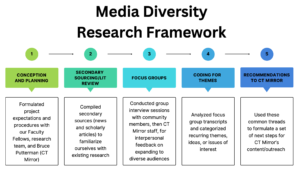Research Questions/Approaches
The overall goal of our research project was to build a deeper connection between the public discourse reported in the CT Mirror and Hartford’s black and brown neighborhoods. To achieve this, our research categorizations are as follows:
What topics related to state public policy are most of interest to Hartford’s communities of color? What public policy issue could the CT Mirror help residents learn about, and how?
How do Hartford’s communities of color get their news? What are the most popular news outlets? How do they consume their news – print, TV, radio, web, or other ways? Does the outlet vary by age group?
How can CT Mirror help change the narrative about reporting from these neighborhoods? How can CT Mirror build connections with residents? What technology would make CT Mirror more accessible?
Our search began by collecting secondary sources about our subject matter, including internal reviews and social science studies. The building blocks of our research framework stemmed from reports like the following media overview from Hearst CT Media Group, which examined the disproportionate racial representation in its newsroom/opinion staff:
 Credit: CT Insider
Credit: CT Insider
Data Collection
Community Focus Groups:
The data collection process consisted of focus groups, accompanied by follow-up interviews. Focus groups were facilitated with residents from Hartford’s Latinx community, allowing for in-depth discussions and insights.
For the community focus groups, our participants were recruited through Hispanic-serving organizations connected to Trinity through CHER and our faculty fellows: the Hispanic Health Council, Hartford Deportation Defense, and Park Street Library. We conducted 3 focus groups for a total of 23 participants, in Spanish for language accessibility.
The decision to conduct focus groups with residents from Hartford’s communities of color was based on the recognition that community engagement and personal interactions can provide valuable qualitative data. By facilitating these discussions, we aimed to create a safe and inclusive space for participants to share their thoughts and experiences– most exemplified by the words and ideas they shared with us. To streamline our dialogues, we combed through each focus group recording and coded the transcripts for common themes
Conversation with CT Mirror Staff:
In addition to facilitating these community focus groups, we conducted a focus group with CT Mirror Staff themselves to relay their personal perspectives on how they could expand their reach. We combined the internal findings of this group with our external community groups to uncover news consumption patterns, outreach methods, and topic preferences that could better connect underrepresented communities with CT Mirror’s reporting.
Data Analysis
The qualitative data from the focus groups were transcribed and coded for themes and patterns. This involved identifying recurring topics, sentiments, and perspectives expressed by the participants as well as specific story ideas for future reporting.
Our overall methodological choices were driven by the desire to capture a comprehensive understanding of the research questions and to ensure the validity and reliability of our findings. We were able to gather a diverse range of perspectives and insights from both categories of focus groups.
